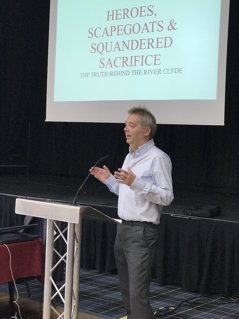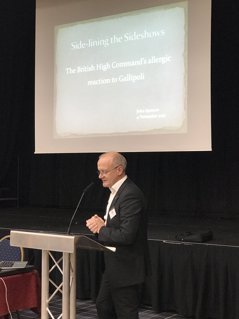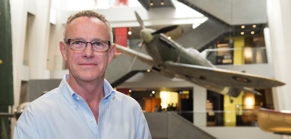GALLIPOLI CONFERENCE, BIRMINGHAM 2017
GALLIPOLI CONFERENCE, BIRMINGHAM 2017
Stephen Chambers, who organised the conference with the assistance of James Watson Smith, welcomed those attending and thanked the four speakers who had given up their time to address the conference. Stephen noted that Major Herbert James who had been awarded the Victoria Cross for the most conspicuous bravery during operations at Gully Ravine on 28 June and 3 July 1915 had been born not far away from the conference venue and had taught at several schools in the Birmingham area before joining the army from which he retired in 1930. Sadly, his death in west London in 1958 went unnoticed and it was not until 2008 that he was commemorated in Kensal Green Cemetery; the project being supported by the Gallipoli Association.
 The first speaker was Professor Peter Doyle whose talk Terrain, Maps & Failure at the Dardanelles focussed on the part terrain and maps played in the Gallipoli campaign and whether sufficient information was available to General Hamilton and those responsible for planning the landings. Using maps and photographs of the terrain to illustrate his talk, Peter accepted that the navy’s failure to force the Dardanelles left Hamilton with limited options but rejected the claims Hamilton advanced later that he had not been provided with sufficient information by the War Office about the geography of the peninsula and that the maps available were inadequate.
The first speaker was Professor Peter Doyle whose talk Terrain, Maps & Failure at the Dardanelles focussed on the part terrain and maps played in the Gallipoli campaign and whether sufficient information was available to General Hamilton and those responsible for planning the landings. Using maps and photographs of the terrain to illustrate his talk, Peter accepted that the navy’s failure to force the Dardanelles left Hamilton with limited options but rejected the claims Hamilton advanced later that he had not been provided with sufficient information by the War Office about the geography of the peninsula and that the maps available were inadequate.
Peter pointed out that Hamilton had access to intelligence reports and maps of landing places and defences, together with Ottoman Army Handbooks and other material; and whilst no large scale maps were available to either side at the time of the landings, the British 1908 Map could not be said to have failed. This was based on a French 1:50,000 map produced in 1854, converted to at a scale of 1:63,360 and although the conversion ‘smoothed out’ some of the detail, this was not material in terms of the Helles landings. In Peter’s view, the crucial fact was that the beach areas were organised for defence by the Ottoman forces who made good use of the terrain and became killing grounds.
At ANZAC the terrain and geology was unlike that at Helles and posed other problems but the landings were broadly in the right place and map accuracy was perhaps of less importance with landings in darkness. However, once inland and with the advent of trench warfare at ANZAC and Helles the need for new and accurate maps became a priority, many being based on captured maps and on aerial photography. In conclusion, Peter contended that Hamilton had the best available information and that the maps were not responsible for the failure at Gallipoli. It was the terrain and above all the stubborn defence by the Ottoman forces that had lost the campaign for the allies in the first few days.
After a short break for refreshments, Stephen Snelling gave an illustrated talk entitled ‘Heroes, Scapegoats and Squandering Sacrifice: The truth behind the River Clyde’s epic odyssey’. Stephen noted that for many years the River Clyde had featured on the cover of The Gallipolian which was fitting given the important part the vessel played in the landing at ‘V’ Beach where 9 VCs were won in 48 hours.
The River Clyde was a late addition to the invasion plan; originally the landings were to have been made in open boats but not enough were available. The architect of the plan to use the River Clyde was Captain Edwin Unwin who was known for getting things done and took the lead in converting the vessel for its new role. He also believed in leading from the front and when the lighters that were to form a bridge to the shore broke adrift from the steam hopper towing them, Unwin and Seaman Williams jumped into the water under heavy fire and attempted to get the lighters into position and rescued men who had been wounded. When they became exhausted Midshipmen Drewry and Malleson together with Seaman Samson took over the dangerous task and struggled to secure lines to the lighters. All were awarded the Victoria Cross in August. The bravery of Sub Lieut. Tisdall who carried on after Unwin was not initially recognised and he was to die in May but his case was pressed by his mother and was awarded a posthumous VC in 1916. 
The second day saw VCs awarded to Col. Doughty Wylie and Captain Walford; the former leading the attack on Hill 141 and the latter on Sedd el Bahr; both perished. Cpl. Cosgrove of the Royal Munster Fusiliers also played an important part in the latter action although his award was not gazetted until August and the bravery of many others like Father Finn, Chaplain of the Munster’s, went unrecognised.
General Hunter-Weston was seen by as the principal scapegoat; he was criticised for insisting on daylight landings at Helles and for the delay in switching troops to W Beach. Stephen’s research also revealed that privately Hunter-Weston did not believe that the landings would go ahead after the navy had failed and did not consider they were feasible. Others criticised were Captain Davidson who commanded HMS Cornwallis and was blamed for staying too long at S Beach rather than supporting the landings at V Beach, and Lt. Col Tizard of the 1st Munster’s who was seen by Unwin and others as ineffective.
Stephen contended that the principal reason for the sacrifice at V Beach was the failure to recognise that the landings would need to overcome strong defensive positions and the lack of firepower to subdue the Turkish defences. For this he felt that the blame must rest on Generals Hamilton and Hunter-Weston.
The first speaker after lunch was John Spencer whose talk, ‘Side-lining the Slideshows: the British High Command’s allergic Reaction to Gallipoli’ focussed on matters of ‘grand strategy’. John explained that the attempts to force the Dardanelles and the land campaign which followed led to a breakdown in the interaction between military leaders and politicians; the failure at Gallipoli permeating British strategy for many years thereafter. Strongly promoted by Winston Churchill, the attempt to force the Dardanelles and the land campaign were seen as means of assisting the Russians and as an alternative to the stalemate on the Western Front. It was opposed by British High Command (notably Haig, French, Robertson) who believed the focus should continue to be on the Western Front; this was essentially a conflict of strategy between the ‘Easterners’ and the ‘Westerners’ both of whom had their supporters and detractors in the War Council and elsewhere.
John highlighted the important role played Sir Maurice Hankey, Secretary to the War Council and later Cabinet Secretary. Hankey was among those who reminded Asquith, the then Prime Minister, of an earlier study in 1907 which had drawn attention to the difficulties in attempting to force the Dardanelles by naval action alone and in mounting a combined amphibious attack. However, despite this and the strong reservations of the High Command the expedition went ahead. The French were reluctant participants and were later to blame Gallipoli for the failure of the 1915 Artois/Loos offensive. By the later summer the British High Command were convinced that the campaign had failed and became increasingly concerned at Hamilton’s demands for more troops. There was also criticism of the planning and conduct of the campaign in the Report of the Dardanelles Commission. The Salonika campaign - seen as another sideshow by the ‘Westerners’ – went ahead under the dark cloud of Gallipoli largely due to French pressure.
The failure of the Gallipoli campaign strengthened the position of the ‘Westerners’. The appointment of Sir William Robertson as CIGS in December 1915 was also significant; he was a strong believer in the primacy of the Western Front and an opponent of ‘side-shows’, and supported Haig against pressure from the new Prime Minister, Lloyd George, who wished to divert resources away from the Western Front. The creation of the Supreme (Allied) War Council in November 1917 and the appointment of Sir Henry Wilson as its British representative undermined Robertson’s influence over strategic decision-making and he was replaced by Wilson in February 1918 who became the predominant influence on the conduct of the war. However, Wilson had no wish to see a diversion of resources away from the Western Front. Thus, John contended, the contagion of Gallipoli on strategic thinking remained.
The final talk - The Vest Pocket Kodak Camera in Gallipoli’ - was given by Jon Cooksey who began by outlining the history of cameras and photograph in previous conflicts. War photography came into its own during the American Civil War and the Mexican war although at this time equipment was cumbersome and cameras recorded images on glass plates. However technical development led to the development of smaller cameras such as the British made ‘Ensignette’ - the first roll film - camera in 1907. This had a great influence on the development of what became known as the Vest Pocket Camera (VPC) by Kodak in 1912. The VPC produced images of consistent quality although its cost was such that initially only the affluent could afford to purchase it. Nevertheless, the numbers sold increased dramatically in the years before 1914 and when war came many were taken to the front, mainly by officers but not exclusively so. To illustrate this, Jon showed examples of photographs published in The War Illustrated in September 1914.
The use of cameras was initially not restricted by military authorities but when the implications in terms of photographs falling into enemy hands was realised their use was banned in March 1915. Despite this, cameras were still being advertised and British newspapers still sought and published war photographs.
In the second part of the talk Jon showed a selection of photographs taken during the Gallipoli campaign; these included ‘Anzac soldiers on the Pyramids at Giza’, a photograph taken from the River Clyde and ‘climbing practice at Anzac’ - a re-creation of the taking of Table Top. More controversial was one taken on 25 April showed ‘Straggling at Anzac’; this featured wounded but also many seemingly unwounded troops resting on the beach – a photograph which didn’t find its way into the Official History! Another showed Turkish prisoners under guard although the former appeared to have uniforms in much better shape than their ragged guards! Jon had researched many the photographers and some of their subjects, which added further interest to this fascinating talk.
The conference was brought to a close by our Chairman, James Stopford, who thanked the speakers for their excellent presentations and also those who had organised the conference or assisted on the day. The conference was followed by the Association AGM and an informal dinner which was much enjoyed by those attending.
Foster Summerson
